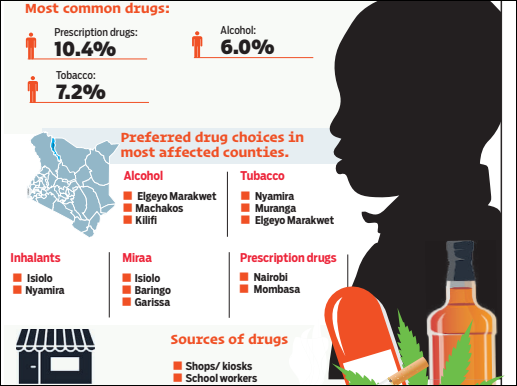
Children as young as four are not only being exposed to but are using hard drugs while in their institutions of learning, a new report shows.
It also shows that the number of children abusing prescription drugs, alcohol, bhang and cigarettes is at an all-time high with some of their trusted handlers responsible for introducing them to the hard drugs even as schools reopen for the new year.
The revelations, contained in a report by a public policy agency, shows why parents need to be worried about their child’s safety because other than learning, school is increasingly becoming a playground for tragic exposure and deadly experimentation that is leading to chronic addiction.
Also shocking is that more than half of the children interviewed for the study said they would not say no when someone tried to get them to smoke.
In the face of these new statistics, primary school heads have accused regional administrators for failing to tame the increasing avenues of drugs and alcohol distribution sources around schools.
Kenya Primary School Heads Association (Kepsha) national chairman Shem Ndolo said many schools have been affected by the drugs menace with many pupils impregnated and several dropouts recorded.
“The local administration have been lenient and some even compromised to look the other way as children’s lives are destroyed,” said Ndolo.
The Ministry of Education banned the establishment of shops and brewing dens around schools, saying they were conduits for drugs supply to schools. With no enforcement, the routes still exist and remain the first point of contact with drugs for many pupils.
“The minimum reported age for the first time use of alcohol, tobacco and inhalants was four years. For bhang and cocaine, the minimum reported age for first time experimentation/use was six years while that of cocaine was 10 years,” reads the report conducted last year.
What is further shocking is that based on pupil testimonies, nearly half of them would not say no when someone tries to get them to smoke a cigarette.
The government set up National Campaign Against DrugAbuse Authority (Nacada) in 2007 to coordinate a multi-sectoral campaign against drug abuse in Kenya and the Kenya Anti-Narcotic Unit.
Nacada is expected to design interventions targeting drugrefusal skills, assertiveness and self-control skills among pupils. But the children remain vulnerable.
“Our children even as young as six are already abusingtobacco and muguka. Their next drugs of choice will be hard drugs,” Mombasa-based Nacada official Farida Tole says. “The children do not even eat. When they are given money for lunch they opt for the drugs which are now sold in smaller, cheaper portions instead of food.”
Parents have reacted sharply to the report findings and are pointing fingers at the Ministry of Education’s quality assurance officers.
Stay informed. Subscribe to our newsletter
“We are not happy because the ministry comes up with policies that they do not enforce. They have also failed to implement the most recent report on causes of schools unrest which listed drugs and alcohol abuse as a major cause,” National Parents Association national chairman Nicholas Maiyo said.
The report, An Assessment of Knowledge, Attitudes and use of Drugs and Substances of Abuse among Primary SchoolPupils in Kenya, was published by Kenya Institute for Pubic Policy Research and Analysis (Kipra) late last year. It mainly covered pupils in primary school in Class Five through Eight, which corresponds to individuals aged 11-15 years.
The document finds that the lack of information at these lower levels of learning has resulted in limited evidence on drug use and substance abuse status of primary school age children.
“There is little evidence on primary school pupils’ knowledge and attitudes of drug use and substance abuse, availability and access to drugs, prevalence rates and age of first drug or substance experimentation.”
For Tole, the rampant abuse among this age bracket has greatly affected education standards, particularly in Coast region.
“Children cannot concentrate in class. All they think about is the drugs and how to access them,” Tole says.
Preventive approach
Maiyo says parents want a more preventive approach to fighting drug abuse.
“The ministry must stop firefighting all the time but parents must also do their part instead of leaving everything to teachers.”
About 4,000 pupils in 200 public primary schools in Kenya were targeted and the pupil response rates were 82.7 per cent in 177 primary schools.
Overall, the report finds that the most readily available drugsare tobacco, prescription drugs, and alcohol.
“Prescription drugs were ever used by 10.4 per cent of the pupils. About 7.2 percent of the pupils indicated they ever used alcohol while 6.0 per cent indicated they ever used tobacco,” reads report.
Lifetime use
The data also inquired self-reported lifetime use of the other drugs, including cocaine, heroin, and inhalants, which were lower than one per cent.
Prevalence is higher for boys in the use of most drugsincluding alcohol relative to abuse among girls. Prescription drugs were perceived as the most available with a proportion of 17 per cent of the pupils indicating they are easy to access.
Other drugs that were perceived to be relatively more accessible were tobacco and alcohol with a respective eight per cent and six per cent of pupils indicating they were easy to access.
At county level, the report finds that alcohol was perceived to be most readily available around the school environment by pupils from Elgeyo Marakwet and Machakos counties at 40 per cent each and Kilifi County at 36 per cent.
Availability of bhang’ was highest for Nyamira, Garissa and Isiolo. Tobacco was perceived to be most readily available in Nyamira, Murang’a and Elgeyo Marakwet.
Isiolo and Nyamira counties had the highest stated availability of inhalants at 40 per cent and 36 per cent respectively.
“Relative to other counties, the largest proportion of pupils from Isiolo and Baringo indicated that miraa was readily available followed by Garissa,” reads report.
Over the years, reports of alcohol and drugs abuse have been cited to be prevalent in schools because of their availability around the institutions. The report says that children easily access drugs from nearby shops and bars. In the absence of these, matatu touts and chemists become readily available conduits.
The report emphasises the enforcement of guidelines on construction of structures (including business premises) near schools. It also recommends that the government enforces the ban on sale of cigarettes in single sticks and calls for the sensitisation of parents on risky behaviours like keeping drugsat home.
For nione-year-old Hilda Achieng, it is not only the keeping of the drugs, but its brewing that has her tethering on the edge of drug abuse. A simple push might result into a life of addiction.
At her age, she knows how good chang’aa should smell like. She knows a stronger, almost choking smell means the alcohol has been brewed to perfection. Right from when she was a little girl growing up in Obunga slum, her mother taught her how to know the alcohol is ready.
Sometimes, when she is helping her mother serve the many customers every day, she gulps he remnants in the glasses.
“She does not get drunk. What she drinks is too little to affect her,” her mother says, letting out a loud laugh when asked about the fears of early addiction.
Hilda is among the many children who are exposed to drugsfrom a young age, and they grow up regarding alcohol abuseas the norm.The report said Kakamega County was notorious for this, with pupils accessing chang’aa and busaa from home as majority of their parents were brewers.
In Busia, children are considered to be among the top transporters of drugs across the border. They are used by unscrupulous traders who give them sachets of whiskey and rolls of bhang to ferry to Uganda and back. ?
The Kipra report finds that although the knowledge of the harmfulness of drugs and substances is generally high across the counties for most drugs, cases of low rates of knowledge associated with the damage drugs may cause are pronounced.
 The Standard Group Plc is a
multi-media organization with investments in media platforms spanning newspaper
print operations, television, radio broadcasting, digital and online services. The
Standard Group is recognized as a leading multi-media house in Kenya with a key
influence in matters of national and international interest.
The Standard Group Plc is a
multi-media organization with investments in media platforms spanning newspaper
print operations, television, radio broadcasting, digital and online services. The
Standard Group is recognized as a leading multi-media house in Kenya with a key
influence in matters of national and international interest.
 The Standard Group Plc is a
multi-media organization with investments in media platforms spanning newspaper
print operations, television, radio broadcasting, digital and online services. The
Standard Group is recognized as a leading multi-media house in Kenya with a key
influence in matters of national and international interest.
The Standard Group Plc is a
multi-media organization with investments in media platforms spanning newspaper
print operations, television, radio broadcasting, digital and online services. The
Standard Group is recognized as a leading multi-media house in Kenya with a key
influence in matters of national and international interest.









